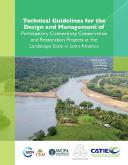| dc.contributor.author | Herrera F., Bernal | |
| dc.contributor.author | Chassot, Olivier | |
| dc.contributor.author | Monge, Guiselle | |
| dc.contributor.author | Canet, Lindsay | |
| dc.coverage.spatial | Turrialba, Costa Rica | |
| dc.date.accessioned | 2016-08-24T13:30:06Z | |
| dc.date.available | 2016-08-24T13:30:06Z | |
| dc.date.issued | 2016 | |
| dc.identifier.isbn | 978-9977-57-662-6 | es_ES |
| dc.identifier.uri | https://repositorio.catie.ac.cr/handle/11554/8423 | |
| dc.description.abstract | This document recounts the authors’ experience in participatory conservation processes that seek terrestrial biodiversity connectivity. It synthesizes at least a decade of research and practice. Its documentation of this experience hopefully can contribute to the conservation and restoration of ecological connectivity in other parts of Latin America and the world. We further hope that these guidelines might be adapted to the biophysical, socio-economic, and institutional conditions of each site. Although related themes such as governance are discussed, this topic requires greater development. Nevertheless, it should be recognized that some countries (e.g., Costa Rica) have created policies, regulations, and incentives to improve governance (Lausche et al. 2013). The paper also presents a case study from Costa Rica (the San Juan-La Selva Corridor), which exemplifies the application of these guidelines and thus the process of constructing the corresponding ecological and governing institutions and public forums. The guidelines are complemented with a glossary, which provides the definition of key concepts related to conservation connectivity science. This paper transcends a strictly ecological perspective of a biological corridor as proposed by various authors (e.g., Bennett 1998). These view the biological corridor as merely a linear habitat of various types that interconnects important habitat core areas in order to maintain wildlife populations. Although we preserve this focus, our experience shows that biological corridors can also serve as platforms for diverse stakeholder and institutional participation that seeks both conservation connectivity as well as sustainable development and human wellbeing. | |
| dc.description.sponsorship | CATIE - Centro Agronómico Tropical de Investigación y Enseñanza, Turrialba, Costa Rica | |
| dc.format.extent | 45 páginas | |
| dc.language.iso | en | es_ES |
| dc.relation.ispartof | Serie Técnica. Boletín Técnico, | es_ES |
| dc.relation.ispartofseries | Serie Técnica. Boletín Técnico, no. 82 | |
| dc.rights | info:eu-repo/semantics/oénAccess | |
| dc.subject | CONSERVACION DE LA NATURALEZA | |
| dc.subject | ZONAS PROTEGIDAS | |
| dc.subject | ORDENACION DE RECURSOS NATURALES | |
| dc.subject | CONECTIVIDAD DEL HÁBITAT | |
| dc.subject | ECOLOGIA | |
| dc.subject | PAISAJE | |
| dc.subject | PARTICIPACION COMUNITARIA | |
| dc.subject | GESTION DEL CONOCIMIENTO | |
| dc.subject | RESTAURACION DEL PAISAJE FORESTAL | |
| dc.subject | AMERICA LATINA | |
| dc.title | Technical guidelines for the design and management of participatory connectivity conservation and restoration projects at the landscape scale in Latin America | es_ES |
| dc.type | Libro | es_ES |


